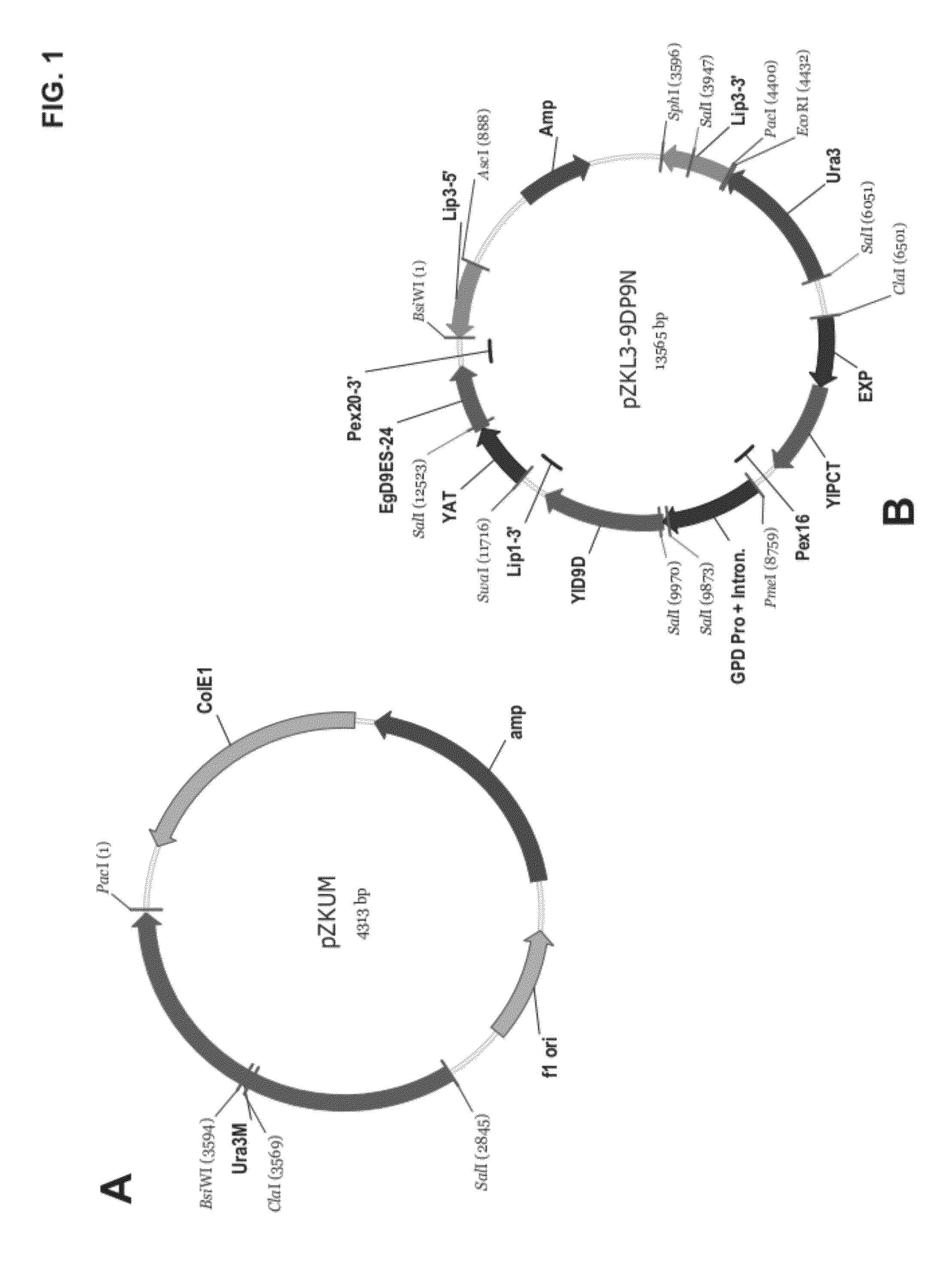Aquaculture feed compositions
a technology of compositions and feeds, applied in the field of aquaculture, can solve the problems of low efficiency of sda conversion to dha in fish, and the rapid growth of aquaculture industry cannot continue to rely on finite stocks of marine pelagic fish as a supply of fish oil
- Summary
- Abstract
- Description
- Claims
- Application Information
AI Technical Summary
Problems solved by technology
Method used
Image
Examples
example 1
Oil Composition of Yarrowia lipolytica Strain Y4305 F1B1 Biomass in Comparison to Fishmeal, Fish Oil and Rapeseed Oil
[0201]Yarrowia lipolytica strain Y4305 F1B1 biomass was prepared and made into flakes, as described in General Methods. Oil was extracted from the whole dried flakes by placing 7 g of dried flakes and 20 mL of hexane in a 35 mL steel cylinder. Three steel ball bearings (0.5 cm diameter) were then added to the cylinder and the cylinder was placed on a vibratory shaker. After 1 hr of vigorous shaking, the disrupted biomass was allowed to settle and the solution of oil in hexane was poured off to yield a clear yellow liquid. This liquid was then poured into a separate tube and subjected to a nitrogen stream to evaporate the hexane, thereby leaving the oil phase in the tube. It was determined that about 34% of the biomass was oil. The composition of the oil was analyzed by GC, as described in General Methods.
[0202]In addition, the fatty acid composition of fish meal oil, ...
example 2
Comparison of a Standard Aquaculture Feed Formulation to an Aquaculture Feed Formulation Including Yarrowia lipolytica Y4305 F1B1 Biomass
[0207]A standard aquaculture feed formulation was compared to an aquaculture feed formulation containing Yarrowia Y4305 F1B1 biomass.
[0208]The Yarrowia Y4305 F1B1 biomass-containing aquaculture feed was formulated using extruded Yarrowia Y4305 F1B1 biomass, prepared as described in the General Methods (supra). Specifically, a portion of the fish oil that is typically present in a standard fish aquaculture feed formulation was replaced with a combination of Yarrowia Y4305 F1B1 biomass and soybean oil. The prepared Yarrowia Y4305 F1B1 biomass, which contained about 34% oil (Example 1), was included as 20% of the total feed on a weight basis. Soybean oil is devoid of EPA and DHA. Fishmeal included in the aquaculture feed formulation was expected to contribute some EPA and DHA. Other standard industry ingredients that provide nutritional benefit in ter...
example 3
Comparison of Standard Feed Formulations to Feed Formulations Including Variable Percentages of Yarrowia lipolytica Y4305 Biomass
[0215]Two different standard aquaculture feed formulations, comprising rapeseed oil or a combination of rapeseed and fish oil, were compared to three different aquaculture feed formulations containing Yarrowia lipolytica Y4305 biomass.
[0216]As described in the General Methods, while Y. lipolytica strain Y4305 F1B1 (used in Example 2) contains approximately 28-38% fat (i.e., measured as average lipid content [“TFAs % DCW”]) and approximately 15% EPA (i.e., measured EPA content as a percent of the dry cell weight [“EPA % DCW”]), Y. lipolytica strain Y4305 contains approximately 20-28 TFAs % DCW and approximately 13 EPA % DCW / . Aquaculture feed formulations comprising the Yarrowia Y4305 biomass, as described in the present Example, were therefore expected to have different compositions than the aquaculture feed formulations prepared in Example 2, comprising t...
PUM
 Login to View More
Login to View More Abstract
Description
Claims
Application Information
 Login to View More
Login to View More - R&D
- Intellectual Property
- Life Sciences
- Materials
- Tech Scout
- Unparalleled Data Quality
- Higher Quality Content
- 60% Fewer Hallucinations
Browse by: Latest US Patents, China's latest patents, Technical Efficacy Thesaurus, Application Domain, Technology Topic, Popular Technical Reports.
© 2025 PatSnap. All rights reserved.Legal|Privacy policy|Modern Slavery Act Transparency Statement|Sitemap|About US| Contact US: help@patsnap.com

